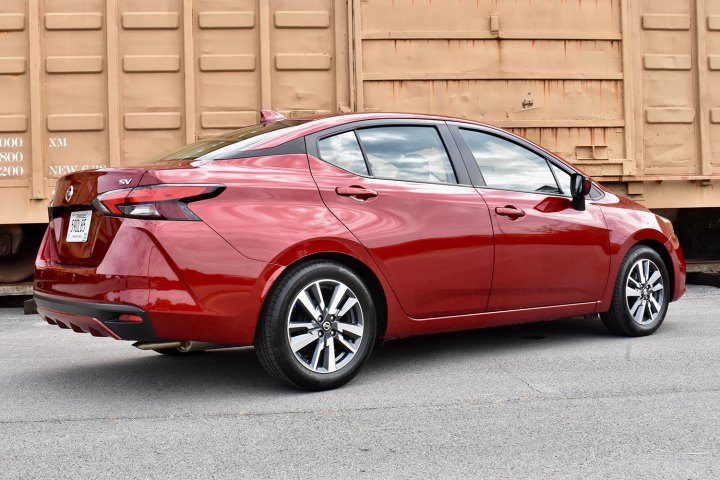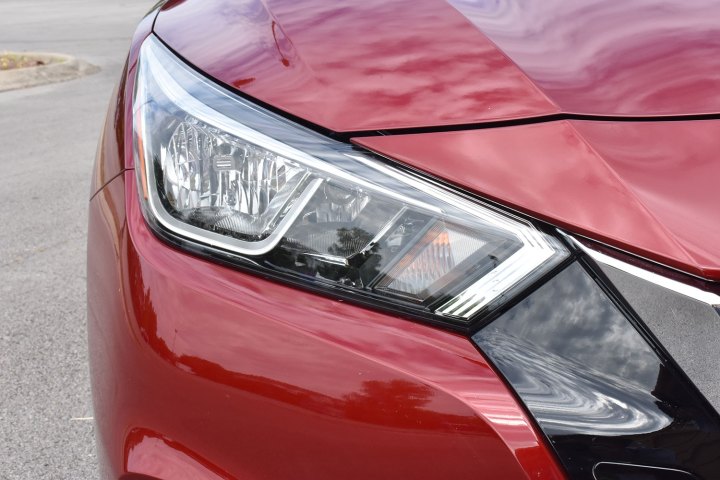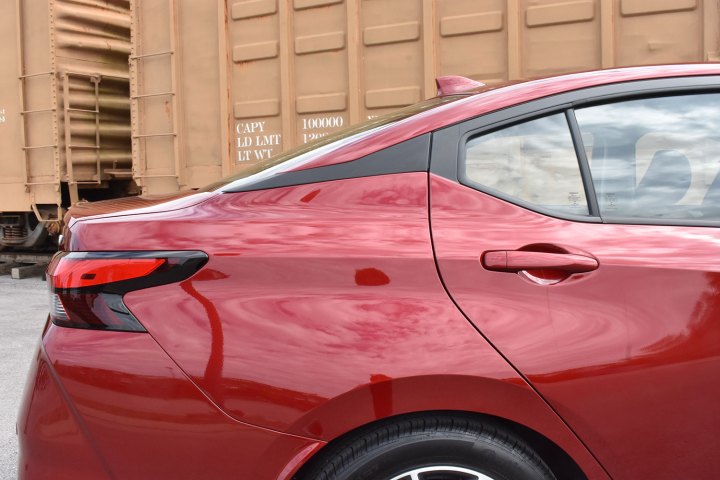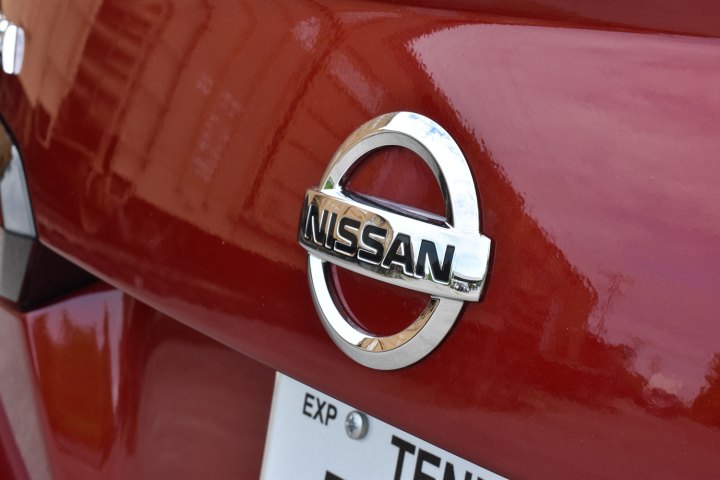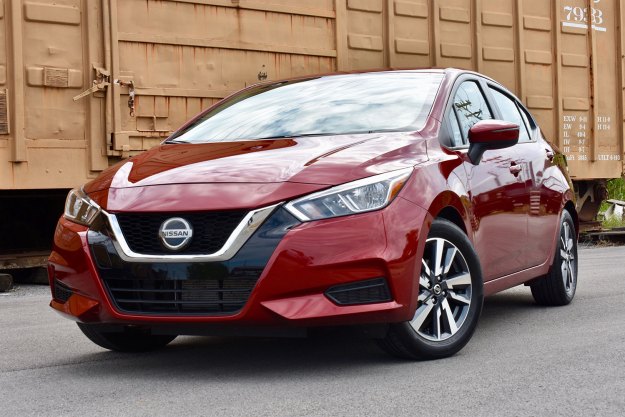
“What it lacks in fun, the 2020 Nissan Versa makes up for in practicality and tech.”
- Exterior styling
- Comfortable front seats
- Long list of available driver-assist features
- Lack of power
- Uninspired handling
- Basic infotainment system
The 2020 Nissan Versa is not the kind of car most people buy by choice. The Versa competes against a shrinking pool of subcompact sedans – such as the Hyundai Accent and Toyota Yaris – for buyers who require a new car, but can’t afford anything beyond the most basic transportation.
With its redesign of the Versa, though, Nissan tried to give buyers more reasons to consider its most diminutive offering. The Versa now sports a more stylish exterior and more tech than ever. Given how well the Nissan Kicks functions as simple, basic, transportation, we were eager to see if Nissan could work the same magic on the 2020 Versa.
To find out if the Versa lived up to those modest expectations, Digital Trends headed to Nashville, Tennessee, a stone’s throw away from Nissan’s North American headquarters. We grabbed the key fob to a Versa SV model, the middle step in the three-tier Versa lineup. Our test car’s $18,535 base price split the difference between the $15,625 base price of the cheapest Versa S, and the $19,135 starting price of the top Versa SR (all prices include a mandatory $895 destination charge).
No longer anonymous
The previous-generation Nissan Versa sedan was a virtually style-free car. No thought seemed to have gone into the way it looked, sharply contrasting the bold styling choices Nissan made with many of its other cars. While the appeal of styling is always subjective, it’s clear Nissan put more effort into the 2020 Versa. The pint-sized sedan borrows styling elements from the larger Altima, including, a “floating” roof visually separated from the rest of the body by blacked-out trim pieces, and Nissan’s ubiquitous “V-Motion” grille. The Versa is also longer, lower, and wider than before – the classic recipe for improving the appearance of a car. The design is clean, avoiding exaggerated elements like the Toyota Yaris’ massive grille, and it’s distinctly Nissan.
Many buyers looking for no-frills transportation may not care about styling, but that doesn’t mean automakers should ignore it. An entry-level car shouldn’t have to be a penalty box. Automakers should try to make cars appealing even if customers are spending less. The Versa is no Aston Martin DB11, but at least Nissan made an effort with the styling this time.
Like the exterior, the Versa’s interior cribs a lot from the Nissan Altima. The dashboard has the same horizontal design, incorporating the central touchscreen into a hockey-stick-shaped trim element. Nissan wanted to get away from the bulbous center stack used in the previous-generation Versa, and it’s hard to argue with that decision. Like the Altima, the Versa’s steering wheel also has a flat bottom, which serves no obvious purpose.
While the Versa’s interior may look like a shrunken version of the Altima’s, the difference in quality is very clear. Almost everything you touch is some variety of cheap plastic, which is to be expected at this price point. The interface for the 7.0-inch touchscreen is so basic that there is almost no reason for it to be there. Apple CarPlay and Android Auto are available, but you have to trade up from the base S trim level to the SV. The Versa has three USB ports, including one beneath the touchscreen for charging and connectivity, and two at the back of the center console for charging only. They should be within reach of backseat passengers, and it’s safe to leave a phone in the front cupholders without it becoming a projectile.
The Versa is also longer, lower, and wider than before – the classic recipe for improving the appearance of a car.
The Versa is a great car to ride in, as long as you’re sitting in front. The Nissan offers more front headroom and legroom than competitor models like the Hyundai Accent, Kia Rio, and Toyota Yaris, but it’s at the back of the pack when it comes to rear-seat headroom and legroom. The driver and front-seat passenger also get Nissan’s “Zero Gravity” seats. They were designed using NASA research on the human body, and while the versions used in more-expensive Nissan models felt better, these were pretty comfortable for economy-car seats.
The amount of trunk space you get depends on the trim level. SV and SR models have 15.0 cubic feet of cargo space, according to Nissan, but the base S model has 14.7 cubic feet. That puts the Versa decisively ahead of all other subcompact sedans except the Chevrolet Sonic, which splits the difference between Versa trim levels at 14.9 cubic feet. Most competitor models are also offered as hatchbacks – usually yielding more cargo space. Nissan currently sells the Versa Note hatchback based on the old Versa platform, but hasn’t confirmed whether that model will stick around.
A car for patient drivers
The 2020 Nissan Versa will get you where you want to go in relative comfort. Just don’t expect to get there in a hurry.
The only engine available on the 2020 Versa is a 1.6-liter four-cylinder, which sends 122 horsepower and 114 pound-feet of torque to the front wheels. The base S trim level comes standard with a five-speed manual transmission. A continuously variable transmission (CVT) is optional on the S, and standard on the SV and SR trim levels.
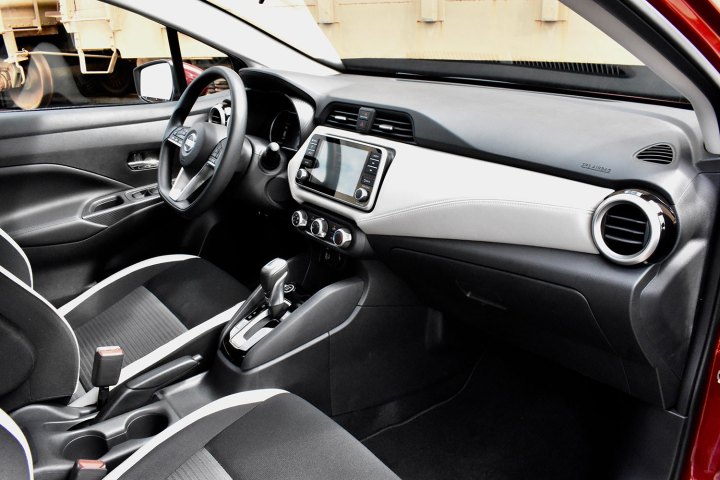
The horsepower and torque figures are respectable for this segment, and should have been adequate for a car of this size. But the Versa is just plain slow. Accelerating uphill and overtaking cars on anything other than a downhill stretch of highway seemed to overwhelm the little four-cylinder engine. Flooring the throttle created a lot of noise, but little actual movement. We don’t expect an entry-level sedan like the Versa to be a rocket ship, but acceleration fell short of what we expect in a modern car.
Driving a small, underpowered car can be a lot of fun, but that’s not the word we’d use to describe piloting the Versa. The oddly-shaped steering wheel did a good job of communicating what the front wheels were doing, but the Versa never really comes alive in corners. The Kia Rio and Toyota Yaris manage to inject some fun into the driving experience, but that didn’t seem to be a priority for Nissan. At least the Versa rides fairly comfortable, and has a pretty quiet interior for an economy car.
The practical stuff
Nissan expects CVT-equipped 2020 Versa models like our test car to get an EPA-rated 35 mpg combined (32 mpg city, 40 mpg highway). Fuel-economy is expected to decrease with the five-speed manual transmission, to 30 mpg combined (27 mpg city, 35 mpg highway). The CVT-equipped 2020 Versa has a slight advantage over automatic-transmission Chevy Sonic, Ford Fiesta, and Kia Rio sedan models, and Nissan’s estimates are identical to the current EPA ratings for the Toyota Yaris. But the Versa falls 1 mpg short of the Hyundai Accent in all three fuel-economy categories.
Flooring the throttle created a lot of noise, but little actual movement.
The Versa comes standard with more driver aids than most competitor vehicles. Autonomous emergency braking, rear automatic braking, and lane departure warning are all standard on the base S trim level, while the mid-level SV adds blind spot monitoring, rear cross traffic alert, a driver-alertness monitor, and a rear-door alert feature designed to prevent people from leaving kids or pets unattended in the back seat. Most of these features are optional extras on other subcompacts sedans – if they’re available at all. Adaptive cruise control is also available on the top SR trim level as part of a $300 option package that also includes heated front seats. The Versa is the only car in this segment to offer adaptive cruise control at any price.
Nissan offers a three-year, 36,000-mile, basic warranty and five-year, 60,000-mile, powertrain warranty. Because the 2020 Versa is a new model, it is difficult to predict future reliability. At least the Versa is a fairly basic car, meaning there is less to go wrong. Crash-test ratings from the Insurance Institute for Highway Safety (IIHS) and National Highway Traffic Safety Administration (NHTSA) are unavailable at this time.
How DT would configure this car
As much as we love a manual transmission, we would have to upgrade from the base Versa S to the CVT-only SV in order to get Apple CarPlay and Android Auto. The SV gets a decent amount of standard equipment for its $18,535 base price, including blind spot monitoring, rear cross traffic alert, satellite radio, and voice control. The SV also gets 16-inch alloy wheels in place of the S trim level’s 15-inch steelies. However, we would ultimately go up one step from the SV to the SR, then tack on the optional Convenience Package to get adaptive cruise control. The SR, which starts at $19,135, also adds automatic climate control, 17-inch wheels, and an upgraded audio system.
Summary
What it lacks in driving fun, the 2020 Nissan Versa makes up for in style and tech. Unlike the previous-generation Versa, you won’t be embarrassed to be seen in the 2020 model. Generous front-passenger space and cargo room mean the 2020 Versa is more than just a pretty face, too. The long list of standard and available driver-assist tech features is also unusual for a car in this price range, even if the infotainment system is still fairly basic. Granted, part of that is down to the Versa being by far the newest design in its segment. Other automakers may add these features as they redesign their subcompact sedans, but then again they may just eliminate those sedans altogether. The Chevy Sonic and Ford Fiesta will likely exit showrooms soon as their makers concentrate more heavily on crossovers.
Should you buy one?
Yes. A Kia Rio or Toyota Yaris may be more fun to drive, but the 2020 Nissan Versa’s stylish exterior, practical packaging, and array of tech features more than make up for that.
